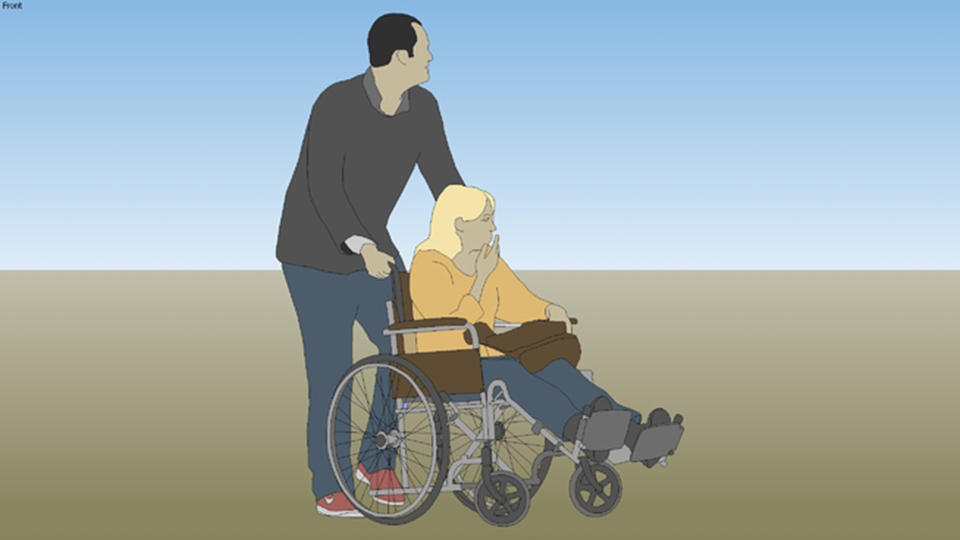
OR

The forms of violence to which girls with disabilities are subjected to in rural Nepal are many.
The advocacy movement of persons with disabilities around the world, as well as in Nepal, has consistently highlighted the plight of the girls with disabilities belonging to indigenous or minority groups. Through passionate defense of equal rights and opportunities by disabled people organizations and persons with disabilities themselves, the general public has been acquainted about the difficulties girls with disabilities face in everyday life, as well as with the barriers that the society puts before them, from inaccessibility of services to social exclusion, to discrimination and stigmatization.
But Nepal has made an important achievement by accepting the United Nations Sustainable Development Goals (SDGs), the Convention on the Rights of Persons with Disabilities (CRPD), and the Convention on the Rights of Child (CRC), all significant international documents that guarantee the rights of girls with disabilities.
The forms of violence to which girls with disabilities are subjected to are many, including physical, psychological, sexual and financial violence, neglect, social isolation, entrapment, detention, denial of health care and forced sterilization and psychiatric treatment.
There is no data on indigenous girls with disabilities. But it is clear that they suffer disproportionately more disability-based discrimination in comparison to the general population. Indigenous girls with disabilities often experience multiple forms of discrimination and many barriers to full enjoyment of their rights, just because of their indigenous status and disability. The discrimination is compounded when female identity is part of the blend.
Girls with disabilities from indigenous or rural communities may lack information about access to violence prevention and response services. Although there is little or no data on violence against indigenous girls with disabilities, the incidence of violence against them is horrendously high, higher than for girls in general.
Remote prospects
The situation is worse for girls with disabilities in remote mountainous areas where there are extreme challenges to access to public services, goods and transport. Rural girls with disabilities have less access to resources, training and skill development due to high illiteracy, negative stereotypes and their overall poor socioeconomic status. For example, in some rural areas of Nepal, girls during their menstruation are kept in an isolated shed as it is feared that if a menstruating girl touches a man or a plant or even an animal, she brings ill omen. This superstitious belief encourages them to leave school.
In the developing world, girls from rural areas are particularly disadvantaged, with the lowest levels literacy and education. Rural girls are predominantly deprived of access to health care. Girls with disabilities have no independent means of livelihood, and thus depend on others for their economic survival. The innumerable issues that confront girls with disabilities are more prominent in rural areas due to inaccessible environments and lack of services, poor information and awareness, and low education and income, resulting in their extreme isolation and invisibility. Rural girls with disabilities have even lower levels of education, employment, and healthcare, all contributing to greater gender-based violence.
Like indigenous and rural girls with disabilities, girls with disabilities who are members of minority groups are subject to multiple forms of discrimination and violence because of their race/ethnicity, gender and disability status. They may be discriminated while accessing education, employment and healthcare. They may experience most severe forms of disability as they don’t even get reasonable accommodations. Racial discrimination and barriers in access to justice, health care, employment, and other factors are compounded for girls with disabilities.
Girls with disabilities experience violence at home from partners or other family members, or from caregivers. When they seek assistance from police or other members of the community, their complaints may not be taken seriously due to old stigma and stereotypes. Moreover, barriers to access justice for girls with disabilities complicate their ability to seek equality and protection.
The Convention of the Rights of the Child (CRC) Article 19 (1) discusses violence against children. It states: “States Parties shall take all appropriate legislative, administrative, social and educational measures to protect the child from all forms of physical or mental violence, injury or abuse, neglect or negligent treatment, maltreatment or exploitation, including sexual abuse, while in the care of parent(s), legal guardian(s) or any other person who has the care of the child”.
The purpose of the UN Convention on the Rights of Persons with Disabilities (CRPD), meanwhile, “is to promote, protect and ensure the full and equal enjoyment of all human rights and fundamental freedoms by all persons with disabilities, and to promote respect for their inherent dignity.” The CRPD also reflects the “Nothing about us without us” principle of inclusion of persons with disabilities. Then, there are the Sustainable Development Goal 4 (SDG4) that aim to “ensure equal access to all levels of education and vocational training for the vulnerable, including persons with disabilities” by 2030.
But, in Nepal, lack of clear legislation that addresses the plight of multi-disadvantaged girls in remote areas is the main stumbling block. Without it, law enforcement agencies may not be able to act to prevent discrimination against girls with disabilities and other marginalized children. Being a party to several international rights instruments, Nepal should prioritize policies to reform discriminatory laws to include all children regardless of their individual difficulties.
The author is a lawyer specializing in disability rights
dev_datta08@yahoo.com
You May Like This

Girls Are Girls: 365 Days a Year, Period
When a young girl child starts to menstruate, the hormonal change in her body alone gives her a hard time.... Read More...

South Korea bomb shelters forgotten with no food, water as North Korea threat grows
SEOUL, July 11: Long within reach of most conventional North Korean artillery and missiles, South Korea and Japan are far from... Read More...

Where adolescent girls succeeded in minimizing child marriage cases
BAITADI, Dec 22: Adolescent girls of Baitadi have succeeded in intervening and stopping 13 cases of would-be child marriages in the... Read More...







Just In
- NRB to provide collateral-free loans to foreign employment seekers
- NEB to publish Grade 12 results next week
- Body handover begins; Relatives remain dissatisfied with insurance, compensation amount
- NC defers its plan to join Koshi govt
- NRB to review microfinance loan interest rate
- 134 dead in floods and landslides since onset of monsoon this year
- Mahakali Irrigation Project sees only 22 percent physical progress in 18 years
- Singapore now holds world's most powerful passport; Nepal stays at 98th












Leave A Comment